| Three Poems by Fred Moramarco | ||
Poetry International
|
At Big Sur Two days of hiking with Stephen, Ama, Vivian, Matthew & Casey July, 1999 Between two giant redwoods, against a backdrop of massive rock, in the back country at Big Creek, ten thousand insects dance and dip in a long ray of sunlight, the light glinting off their wings. I’ve never seen anything like this before: a ballet of light and motion, harbingers of a world I’ve missed. We’ve been noticing things here, attending to what’s around us. On the trail, Stephen teased a funnel spider up from its conical web with a twig. It darted toward the twig, thinking it had snared a grasshopper. I’ve been learning the names of things,and what they smell like: mugwort, vinegar weed, laurel bay,California sagebrush, yerba buena. I tasted a thimble berry, moist and sweet, found a tiny scarlet pimpernel, secretly tucked in the moss filled crevice of a rock. After lunch, four of us sat under a gnarled live oak and talked about the sadness of our lives: depression, panic attacks, Zoloft and Paxil, therapy, divorce and betrayal, loss and secret shame. Around our heads, the insects flitted like gold dust. Later, at the creek, the water rushing by our feet looked too inviting. Everyone stripped and dived in, “a religious experience,” Stephen said. The two women, naked, climbed on a rock, their bodies beaded with light and water, two Eves crouched against the greenery, while four Adams sloshed below. We all have “real lives” to get back to, but isn’t this real life as well? Is this a dream or are the lives we talked about after lunch? As we leave the woods, we’re shown several trays of stuffed animals, gathered road kill and those found dead in the forest: a mountain lion, a fawn, an owl, several skunks and possums, and lots of bones and skulls. Only the bones and skulls look real. And the insects, still dancing in sunlight. A Stone as a Thing of Beauty There’s nothing you can learn more from than a stone, but it takes patience. The rest of nature’s easy to enjoy trees, clouds, rivers, the boundless sky, the moon, the sun, the astonishing stars these even the careless can love. But a stone needs to be approached with care if you want something from it. It rewards a slowness of time: hold it in your hand a while and watch it turn into a mountain; toss it into the air and make it a planet hurtling through the abyss; catch it and feel the way you’ll spend eternity. My Masterpiece I sat down today to begin work on my masterpiece. I opened the file named “mymasterpiece.doc” and there was nothing in it, empty as a beached seashell. So I went to work immediately to begin crafting the poem that I’ll bequeath to posterity as my most important work. First of all, it needs to be generous, compassionate, embracing. It needs the clarity of Buddha, the suffering of Christ, the wisdom of Confucius, the surety of Mohammed, the authority of Moses, and the weaknesses of Bill Clinton. It needs to represent and express humanity with all of its extraordinary contradictions. I want it to be Whitmanic in scope, Dostoevskian in depth, Tolstoian in empathy, Faulknerian in complexity, Joycean in originality, Jamesian in subtlety. But my masterpiece should also be as lucid as Ray Carver, as raunchy as Henry Miller, as angry as Celine, as epigrammatic as Emily Dickinson, as eternal as Homer. Then again, it should not be literary at all It should dance like a butterfly, sting like a bee, It should be very much like Mohammed Ali. I’d like that it contorted be, like one of Shakespeare’s sonnets, but not so twisted and complex that no one understands it. A poem of charity and of hope, with couplets like those of Alex Pope. A little homespun wisdom from Robert Frost from trees and brooks and far off stars. But all these mentors make me nervous; my masterpiece needs to be absolutely original: mine and mine only, recognizable as Marilyn Monroe, standing over a subway grate, her skirt lifted by the breeze. How to begin such a daunting task? Aha! the first line just came to me: “I sat down today to begin work on my masterpiece.” _________________________________________________________________________ FRED MORAMARCO
is Editor of Poetry International and teaches
literature and creative writing at San Diego State University. He is the co-author
of Containing Multitudes: Poetry in the United States since 1950 (Twayne, 1998) and Modern American Poetry (U
of Mass Press, 1992) and co-editor of Men of Our Time: Male Poetry in
Contemporary America Links to some of this work can be found on his website: |
